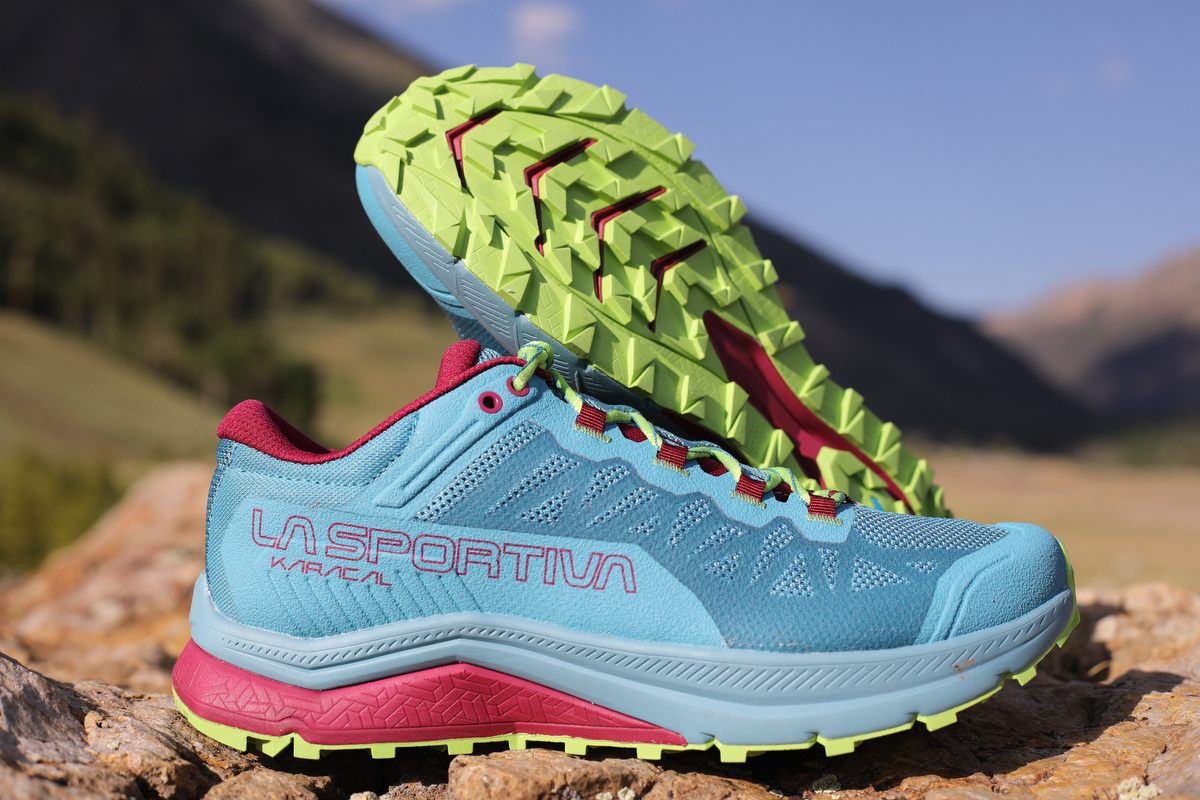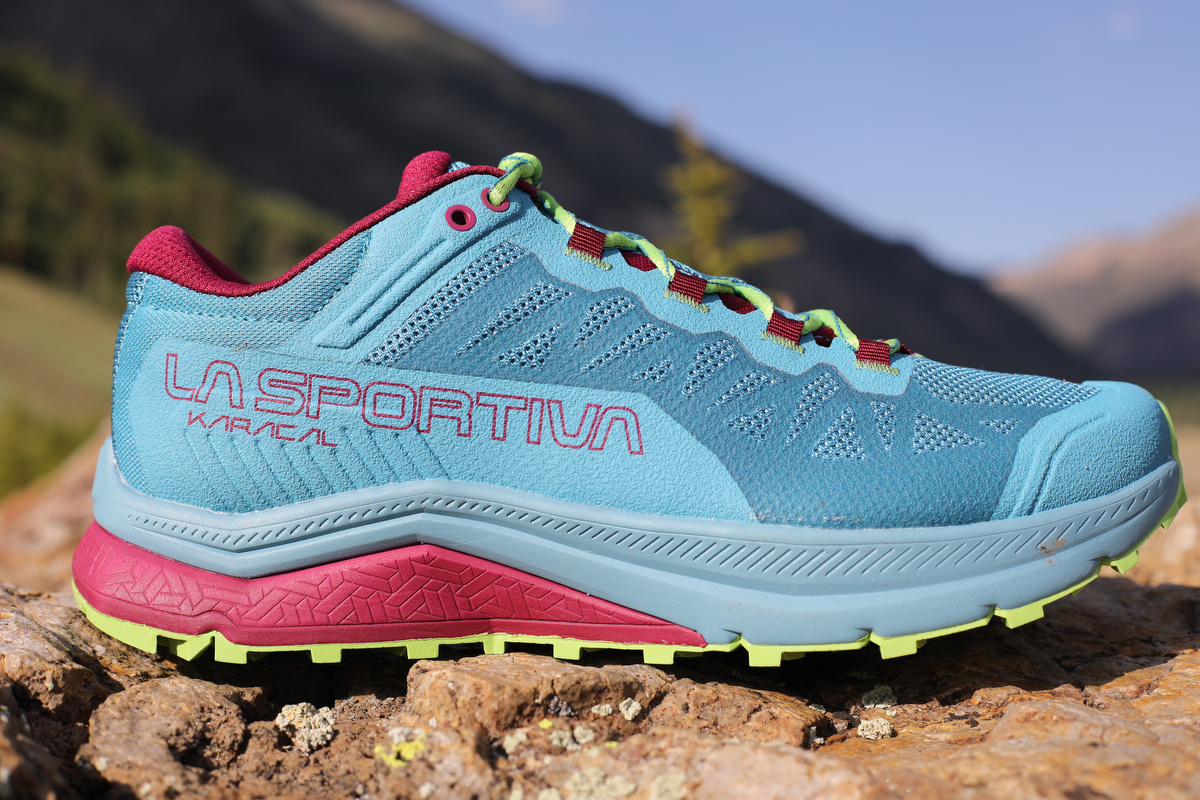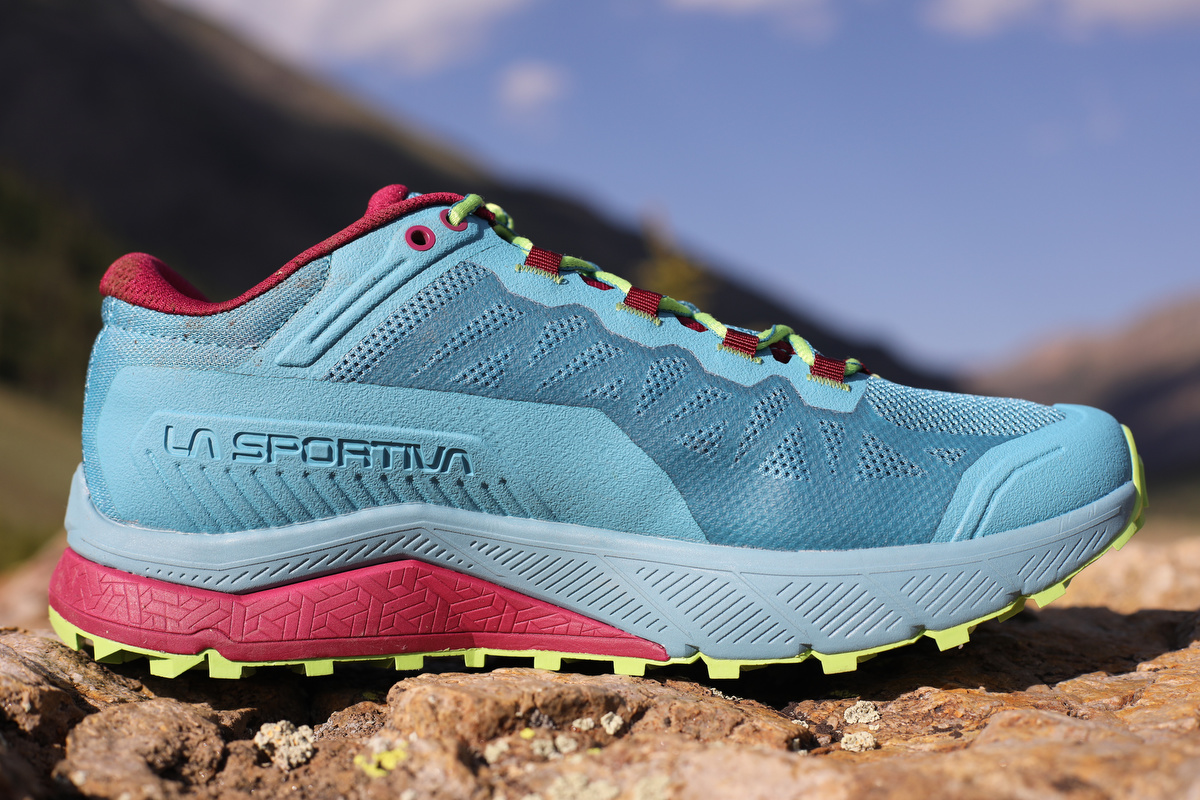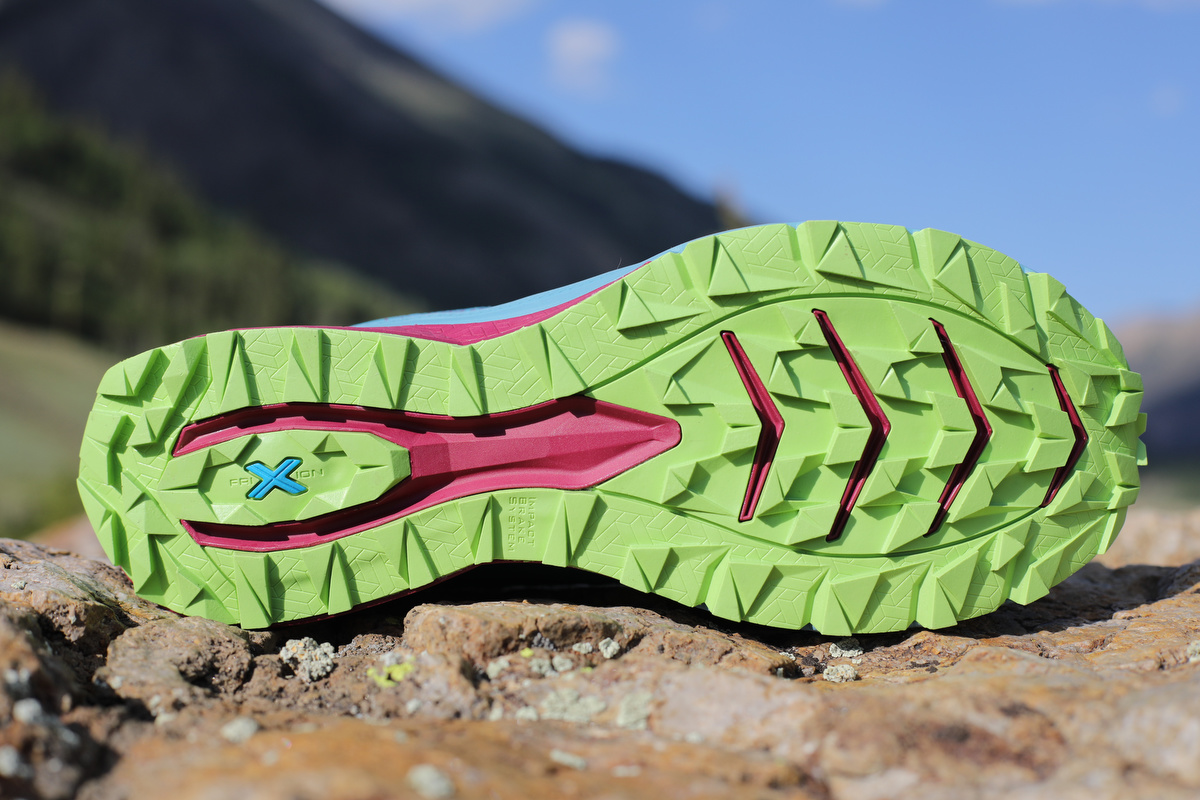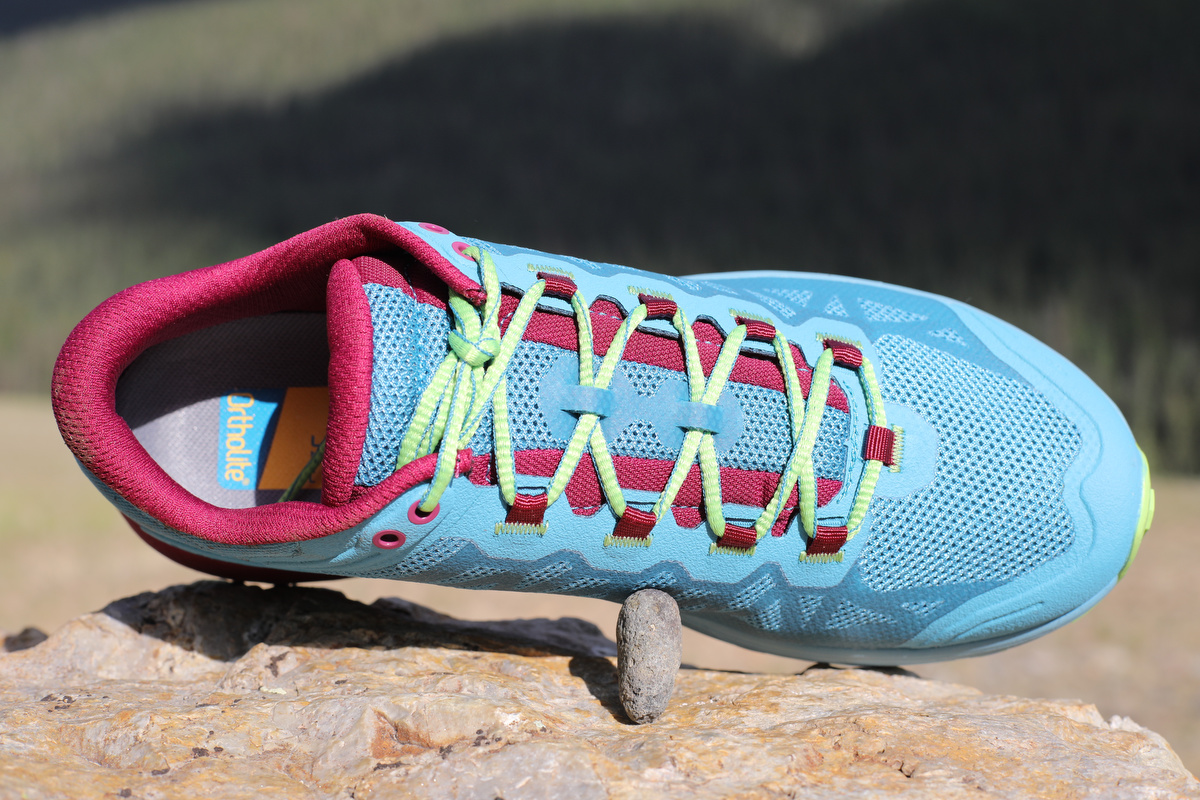If you’ve ever felt a bit left out of the La Sportiva shoe line-up because of the lack of high-volume or wider-fit options, the La Sportiva Karacal ($130) may be your gateway shoe into their mountain running footwear world. For the all-day and all-terrain comfort, cushioning, and protection offered by the Karacal, it is relatively light at an advertised weight of 8.8 ounces (250 grams) for the women’s size 7 and an actual weight of 10 ounces (284 grams) for the men’s size 9. The stack height of 29 millimeters at the heel and 22mm in the toe allows for that 7mm of drop that the La Sportiva Jackal was famous for, thus allowing greater ease with downhills while still protecting the runner’s posterior chain for sustained running on uphills. I am pretty sensitive to low-drop shoes, but I can wear this shoe very comfortably for 20 to 30 miles without the usual chatty calves and hamstrings that tend to pop up when I wear the 6mm and lower drop options.
My all-time favorite shoe from La Sportiva was the Akasha (with heel lifts to increase the 6mm drop), and since they discontinued that shoe in the United States, I’ve felt at a loss for my always-comfortable ultramarathon shoe. The La Sportiva Karacal is proving to be quite versatile, and though it’s not quite the Akasha, it is a worthy option for summer mountain trails, bringing more cushioning and comfort to the table.
Shop the Women's La Sportiva KaracalShop the Men's La Sportiva Karacal
La Sportiva Karacal Upper
The La Sportiva Karacal upper is designed on the Tempo Ultra last with a wide fit to appeal to the long-distance, all-mountain running adventurer. The Karacal is the highest-volume La Sportiva shoe I’ve worn, and it provides all-day comfort, even in hot weather. I don’t typically have foot swelling over the course of an all-day or all-night adventure, but the upper of this shoe remains as comfortable at hour 10 as at the beginning of a run.
The no-sew upper is constructed from a highly breathable, large-pore, seamless mesh overlaid with a thermo-adhesive framework for added support and structure. A high-density external medial and lateral counter in the posterior midfoot and rearfoot add some stability in the upper for when the miles get long and kept my foot securely on the midsole platform in off-camber terrain. The thermo-formed toe cap is also well-structured and provides excellent protection against rocks and roots on technical terrain. The overall airflow through the shoe was welcome during our hot summer, but I didn’t find my feet to be overly cold on 45-degree-Fahrenheit mornings at high elevation either. I haven’t had the opportunity to wear these in significantly cold or snowy weather, but I can see that the breathability might make for some chilly feet this winter.
Web-like overlays connect medially and laterally to the reinforced areas around the lacing components, allowing for a more individualized fit as you adjust the laces accordingly. Two lacing hole options exist at the ankle to further customize the fit using the heel-lock-style lacing technique, which can be helpful if you have a lower volume foot or a foot that changes sizes significantly over the course of a long run.
The well-cushioned, traditional-style tongue is only gusseted about halfway up which sometimes allows it to slide laterally while running, especially when foot placement is all over the place, as sometimes happens in the mountains, but never to the point of altering the fit in an uncomfortable way. I prefer this slightly modernized size and shape of the tongue, as well as the level of cushioning, because it provides excellent protection for the top of the foot from the laces, as well as comfort at the foot and ankle junction if you use the heel-lock lacing strategy. I also found the tongue dries quickly enough after a thorough stream dunking, especially as it is aided by the overall breathability of the shoe. The round laces do tend to loosen, and even work their way out of double knots occasionally, which is mildly inconvenient. Perhaps a sausage-link style would be helpful.
The heel counter is relatively firm and well-structured for added support, but is a bit wider or less snug-fitting of a heel than I’m used to with other La Sportiva models like the Akasha, Jackal, and Lycan. I miss the slightly more secure fit of my heel here, but I haven’t had any issues with blisters which I wondered about initially. Thankfully, the ankle collar is nicely padded without being overdone, and gone is the Achilles tendon irritation from the strange reverse-notch shape used in the Jackal. Though it’s still not the traditional Achilles notch shape, the padding and subtle rise there is comfortable and non-intrusive to the Achilles, as well as the medial and lateral ankle bones. I’ve put this shoe to the test on steep ups and downs and I’ve had zero issues with discomfort here.
La Sportiva Karacal Midsole
The midsole of the La Sportiva Karacal uses 35A cushioning for the heel and 32A cushioning in the forefoot, which provides a very comfortable ride. These trail running shoes are plush and burly enough to double as my choice for fastpacking, backpacking, and race distances up to 100 miles, yet I don’t feel like I’m wasting any energy with bounce or squish. A full-length 1.5mm dual density EVA rock guard effectively prevents any intrusions from rocks or roots, and I have yet to find an exception, even while tromping around on scree and talus just to “see what’s on the other side of the ridge.” As my foot continues to heal from lingering plantar fasciitis, the Karacal is currently the only shoe in my quiver that has enough cushioning and protection at the heel and midfoot to allow me to run and hike on tougher days, though I have added an off-the-shelf insole with a more prominent arch as I continue to rehab. The familiar 4mm OrthoLite insole — which is normally quite comfortable for my high-arched foot — is once again included. This stays in place regardless of how wet or dry the shoe is, and is easily removable to dry or switch out with your preferred orthotics or insoles.
One thing I’ve noticed regarding performance is that the heel-to-toe stiffness versus flexibility balance is perfect. I can climb steep slopes up the 13,000- and 14,000-foot peaks here without overly stressing my foot, and can run on rolling singletrack comfortably without feeling like I’m fighting the stiffness of the shoe. The torsional stability and flexibility balance and the ability to slightly decouple the forefoot and rearfoot, however, is less graceful. There are times when I wish the shoe would allow me to conform slightly more to what’s underfoot to avoid awkward clunking of the shoe toward inversion or eversion, especially on the paths less traveled. It hasn’t been injurious, but at times it’s just a bit more of a clumsy experience compared to the Akasha, Jackal, or Lycan, which all rode that balance between terrain accommodation and protection more smoothly.
Overall, the midsole and ride of the Karacal feel very resilient and responsive despite an increasing number of miles on the shoe. There is less flattening and dulling of the midsole than I have experienced with the Jackal, and they seem to recover overnight for multi-day adventures and explorations without feeling packed out. I have no doubt these will, like the Akasha, last 400 to 500 miles.
La Sportiva Karacal Outsole
The La Sportiva Karacal outsole uses their FriXion AT 2.0 rubber compound with the Impact Brake System. Well-placed and well-spaced 3mm lugs are arranged in the multi-directional chevron and triangle pattern, which provide adequate traction on a wide range of surfaces including jeep roads, angled tundra, talus, and scree. Of the five compound ratings, the FriXion Blue used for the Karacal is on the softer and lower end of grip, however, it receives the highest rating for hard-wearing durability. Compared to other La Sportiva shoes I have with the FriXion Red compound, I honestly don’t notice any significant difference in performance. Thin chevron-shaped cutouts increase the flexibility of the forefoot and lighten the weight through the midfoot and heel, facilitating a smooth heel-to-toe roll-through.
From a running perspective, the Karacal performs well on most surfaces – including slabby rock, dirt and rooty singletrack, jeep roads, and alpine environments. Though my runs tend to be in dry conditions by virtue of Colorado’s climate, they also work well in post-downpour wet dirt or alpine mud as it dries after the snow melts. Thinking back to my U.S. Pacific Northwest days, more aggressive lugs would be preferred for truly muddy conditions. The Karacal’s lugs aren’t quite aggressive enough for steeper ball-bearing rocky slopes, wet, slippery, and mossy rocks, and snow or ice, but they work well enough across all other surfaces that if these more extreme elements aren’t heavily featured in the run, it’s not bothersome. I have about 150 to 200 miles on these shoes now, with a heavy emphasis on the Sawatch and Front Range high country in Colorado, and the lugs are in great shape without noticeable wear and tear.
La Sportiva Karacal Overall Impressions
Overall, the La Sportiva Karacal is an excellent high-volume, wider fitting, all-day mountain adventure shoe option for those of us who like a bit more underfoot. For me, they are an easy choice for pacing, racing, or running multiple types of trails including those found at the Hardrock 100, the Never Summer 100k, and High Lonesome 100 Mile here in Colorado; the Siskiyou Out Back, the Waldo 100k, or the routes around Mount Hood and Mount Saint Helens in the U.S. Northwest; the Grand Canyon or any of the Arizona peaks; and even the incredible routes of the Chugach Mountains or along the Kenai Peninsula in Alaska on their drier days. I recall some adventures in upstate New York and along the Laurel Highlands Trail in Pennsylvania where this shoe would also shine, and I know these shoes would be comfortable in the mountains above Meiringen and Interlaken, Switzerland as well. What they lack in super aggressive traction, they make up for in comfort. Though the midfoot torsional stability may be a little much, I love the ability to climb steep slopes on my forefoot while keeping my feet happy. Adventures that involve more hiking than running and a heavier fastpack instead of a light hydration pack are still within the performance comfort zone of the Karacals. All in all, the La Sportiva Karacal is a very versatile mountain and trail shoe built for the long haul.
Shop the Women's La Sportiva KaracalShop the Men's La Sportiva Karacal
Call for Comments
- Are you running in the La Sportiva Karacal? If so, what do you think about the shoe overall as well as its specific features?
- What do you think of the Karacal compared to other La Sportiva shoes?
[Editor’s Note: If you’re affiliated (i.e., an employee, ambassador, etc.) with a brand, please share your relation in each of your comments on this article. Thanks!]
Our Favorite Trail Running Shoes
Check out our Best Trail Running Shoes article to learn about our current favorite trail running shoes!
